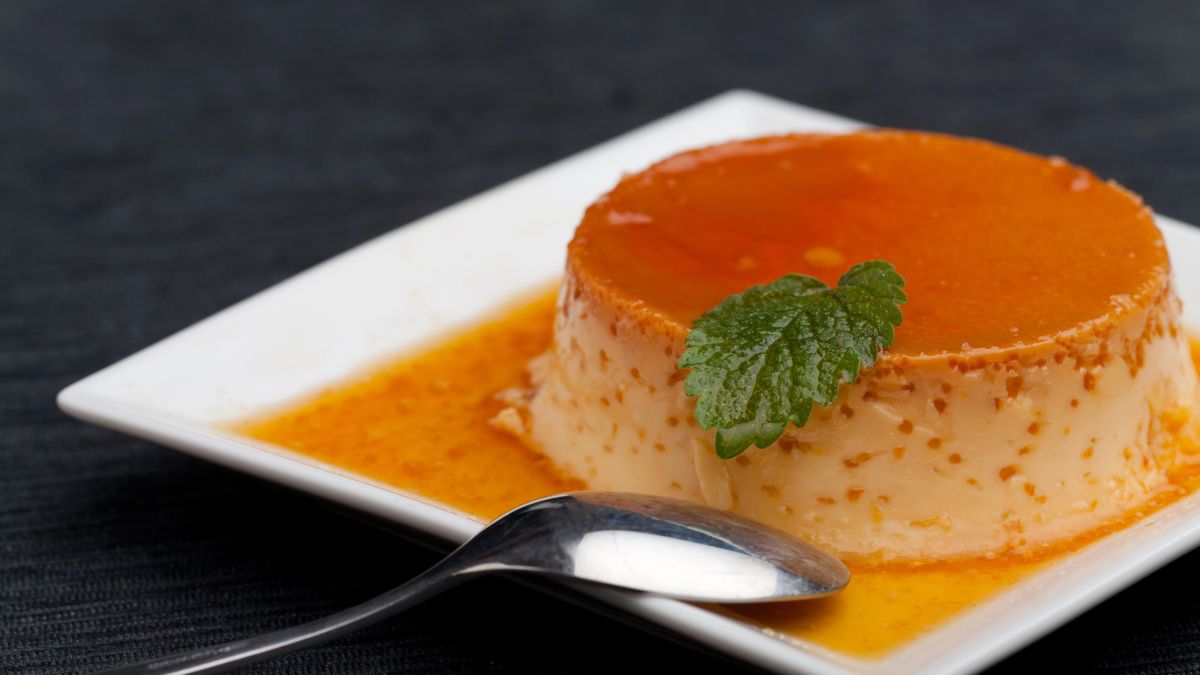The Right Way To Serve Flan

Flan, a silky smooth custard baked in a golden liquid made from melting caramelized sugar, is an extravagant dessert for holidays like Christmas, New Year, Cinco de Mayo, or any other special event. Flan recipes, on the other hand, may appear to be excessively difficult to make for some people. So, how to serve flan and should you eat it hot or cold?
To serve flan, make sure that it is completely cooled. Run a thin knife around it to loosen, and then turn it over onto the plate. Remove ramekin slowly and carefully, allowing the caramel to run over the flan. Add fruit for decoration if wanted, and serve it either warm, cold, or at room temperature. It is creamiest when served warm.
The most common question that flan lovers have is how to serve and store flan. Is it possible to refrigerate flan, and what is the best possible way to eat it? If you were wondering the same thing, don’t worry; I’ve got the answer to all your flan-related questions.
How to take flan out of the mold and serve it?
Flan’s origins can be traced back to Ancient Rome. Romans were the first ones who came up with the idea of cooking eggs and milk together and then covering that dessert with honey. The notion eventually migrated to Spain, where it became a traditional dessert with caramel. During the Spanish conquest, flan was brought to Latin America, and since then, it’s become a truly beloved dish among different nations in all regions of the continent.
Over the years, many countries throughout the world have introduced a variety of flavorings, such as almond and citrus. Mexicans, for example, often include cinnamon in the mixture, and top the dish with local fruits, which go well with flan’s taste.
Flan can be made in many ways, but eggs, dairy, and sugar are stapling ingredients. Furthermore, while flan is often cooked in the oven with the molds swimming in a water bath, certain recipes call for it to be cooked on the stovetop. But the latter takes much longer to complete the dessert.
To serve, loosen the flan by using a little sharp knife against the lid of the flan mold, gently shake it, and overturn it onto a plate. Carefully remove the ramekin from the flan, allowing the caramel syrup to flow over it.
For decoration, you can make different shapes from caramel, use chocolate sauce, or different fruit. There are plenty of flan decoration ideas that can inspire you.
Keep in mind that your guests will probably be thirsty after consuming such a delicious sweet treat, so make sure to provide them with an adequate choice of drink. A Sauternes or Muscat dessert wine is the traditional complement for flans, but we also recommend a semi-dry Champagne, sparkling wine, or perhaps even beer for a more interesting combination.

What to serve with flan?
Flan tastes delicious even on its own. But, if you wish to sweeten things up a bit, you can spread Nutella or chocolate on top of the flan. You might also add fruit, nuts, or coconut to the meal to complement the sugary caramel flavor. You can even top the flan with ice cream or other types of sweets to make it a more complex dessert.
Bread and butter pudding as a side dish is ideal for chilly evenings spent in front of the fireplace. Apple and raisin oat crumble with caramel custard are even better. Moreover, fruity bread pudding with custard is also a delicious dessert option. On the other hand, if you prefer chocolate instead, chocolate pudding with hot cross buns will be a delicious treat for those cold winter afternoons.
Do you eat flan cold or hot?
Flan is simple to make yet always appears stunning and dramatic when served. It should be chilled overnight after cooking to allow the custard to set properly so that when you slice into your delectable cake, all of its yummy sweetness will not run out.
Therefore, most people serve flan cold, but it’s also a good idea to eat it while it’s still warm from the oven because it’s the creamiest then. Alternatively, it can also be served at room temperature. In any case, keep your flan in the baking dish until you’re ready to invert it onto a plate to serve.
Can you reheat flan?
The flans are baked until set in miniature souffle dishes or ramekins. They can be baked and unmolded the day before and reheated later, depending on your preferences.
When you flip the baked flan onto your plate, the caramel sauce transforms into a delectable garnish, which is extremely moist and melts in your mouth. If you prefer your flan to be hot, it’s advised to consume it when it’s still fresh from the oven.
However, you can still warm up your flan if you put it in the fridge overnight. The idea is to briefly immerse your baking dish or ramekin in boiling water. This causes the caramel sauce to melt. If you want your entire flan to be a little warmer, place it in hot water for a few more seconds. Alternatively, it can also be heated in the oven.
Should it be refrigerated?
Custards, such as flan, can survive well in the fridge for several days, so they’re great to make ahead of time for a party. However, when storing it, make sure to keep your flan covered tightly with plastic wrap or aluminum foil since the egg custard absorbs scents quickly. This extra layer will not only prevent moisture from accumulating on top of the custard but also prevent other foods from getting on top of your flan.
When you take your flan out of the fridge, gently warm the caramel so it’s still in liquid form. To do this, you can dip the dish in a pan of hot water for about 3 seconds. Use a thin knife around the dish’s edge to gently shake the flan to release it from the pan and then invert it onto a plate.
Leche flan should be consumed within three to four days of cooking, but it tastes best if eaten within 48 hours. On the other hand, if you put it in the freezer, it will be safe to eat for about one to two months, and it will retain its flavor and texture without much deterioration.
Tips for making a perfect flan
To make the perfect caramel, stir the sugar and water together over low heat until the sugar completely melts. Increase the heat to medium-high and cook without stirring. You will know that the syrup is done when it gets light amber color. It will take you about 7 to 10 minutes.
When it’s done, remove it from the heat and pour it evenly over the bottom of the dish or dishes you’ll be baking the flan in. Tilt the pan so that the caramel covers the bottom and a small portion of the sides.
You’ll know the flan is ready to go when it’s faintly brown and firm to the touch. To double-check, insert the blade of your knife halfway down into the flan; if it’s truly done, the blade should come out clean. Remove the flan from the water bath after carefully removing the baking pan from the oven.
If your flan has got air bubbles, it’s a clear sign you cooked it at too high a temperature. To remove those pesky bubbles, light the blowtorch and swiftly wave the flame a few centimeters or inches above the surface of the custard.
